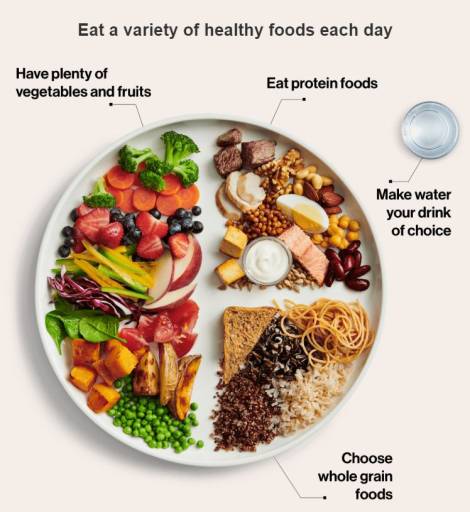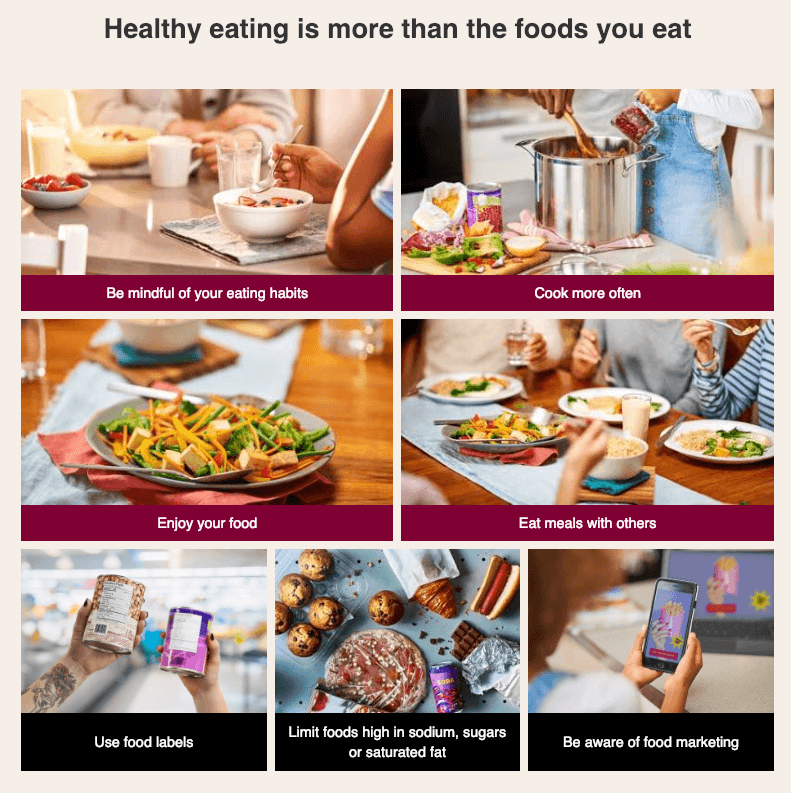
Health Canada has just unveiled the new Canada Food Guide. And it is a serious revolution in nutritional education! It’s holistic. It’s almost “Naturopathic”!
After decades of drilling the concepts of “serving sizes” and “food groups” and the US “Food Pyramid”, this new Food Guide is so different, it doesn’t even mention “serving sizes” or “food groups” – AT ALL!
Here is a rundown of the new food guide, which I will describe using my list of top 5 favourite features of the new Canada Food Guide:
1. ONE SIMPLE PICTURE TO LEARN: The new guide replaces the overly complicated food groups and serving sizes with 1 very simple visual: the healthy plate. The plate shows 3 groups of foods that are visually divided into approximate “portions”: vegetables and fruits (half plate), protein (quarter plate), and whole grains (quarter plate). And as an added bonus, there is a drink on the side, a glass of water with a simple recommendation “make water your drink of choice.”
2. MOSTLY FOCUSED ON FOOD HABITS. Most of the content of the new Guide focuses not on what to eat, but on how to eat. There is a wealth of information and helpful tips to encourage mindful food habits, cooking more often, enjoying your food, and eating meals with others. What the authors of this Guide seem to have really understood is that eating healthy is not just about the food you put in your body, but is significantly affected by our food culture and the psychology around eating. Instead of saying “don’t eat so much junk food,” they are saying “cook more often”. Instead of saying “don’t eat so fast or you’ll overeat” and “don’t eat stressed,” they are saying “enjoy your food” and “eat meals with others.”

3. TEACHING MINDFUL EATING. The guide teaches Canadians to be mindful of their eating habits, which can lead to healthier food choices, eating routines, and eating environment. By focusing on eating mindfully instead of stressing too much about serving sizes and food groups, people become more attuned to their hunger/fullness signals which will naturally control overeating and obesity; and learn to eat slowly, away from their desks, in a relaxed environment which will improve digestion and minimize digestive symptoms like heartburn, indigestion, and gas/bloating.
4. UPDATED FOOD LABELLING. First off, teaching how to read a food label as part of our Food Guide is a great thing. But with this new Guide, there are also going to be some great changes to the way food manufacturers have to label their foods. My two favourite changes, which will make it harder for the food industry to hide calories and sugar, are: 1) serving sizes will be more representative of an actual serving; and 2) sugars will now be grouped together so it will be easier to know how much sugar is actually in the food.

5. FOCUSING ON INFORMED CHOICES. The new guide is not a set of commandments, it is not telling you what you HAVE to eat. Instead, it is focusing on education so that Canadians can make an informed choice. Instead of “don’t drink pop and sugary drinks,” it says “make water your drink of choice.” Instead of just saying “don’t eat junk food,” it says “limit foods high in salt, sugar and saturated fat” and then teaches you that junk food and take out food tends to be high in these ingredients.
There is also a whole section on bringing awareness to food marketing. This section suggests asking yourself questions like “Why do you want to purchase a certain food or drink” with answers like “Do you think its cool?” These are really important questions for kids to learn – did you want this sugary cereal because it tastes yummy, because you saw a cool ad for it, because your friends eat it? Knowing why we make our food choices is really important. You can still choose the junk food, but now you know it is sugary, full of fat and that you are being influenced by a celebrity’s Instagram post!
This guide is definitely not perfect (there are a few points that I don’t completely agree with) but it is a vastly improved change. In fact, it teaches nutrition that is very much aligned with the way Naturopathic Doctors and nutritionists have talked about food and healthy eating for many years. It is a wonderfully modern and holistic way to look at food, and to help all Canadians from school-aged kids to adults to seniors navigate healthy food choices.
Naturopathic Doctor
